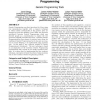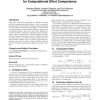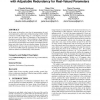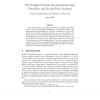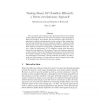GECCO
2007
Springer
15 years 4 months ago
2007
Springer
118
click to vote
GECCO
2007
Springer
15 years 4 months ago
2007
Springer
Genetic Programming was first introduced by Koza using tree representation together with a crossover technique in which random sub-branches of the parents' trees are swapped ...
103
click to vote
GECCO
2007
Springer
15 years 4 months ago
2007
Springer
This paper analyses the reliability of confidence intervals for Koza's computational effort statistic. First, we conclude that dependence between the observed minimum generat...
GECCO
2007
Springer
15 years 4 months ago
2007
Springer
Although multi-objective GA (MOGA) is an efficient multiobjective optimization (MOO) method, it has some limitations that need to be tackled, which include unguaranteed uniformity...
132
Voted
GECCO
2007
Springer
15 years 4 months ago
2007
Springer
We have developed a technique to characterize software developers' styles using a set of source code metrics. This style fingerprint can be used to identify the likely author...
Publication
In this paper we describe a new class of representations for realvalued parameters called Center of Mass Encoding (CoME). CoME is based on variable length strings, it is self-adap...
103
Voted
EUROGP
2007
Springer
15 years 4 months ago
2007
Springer
Abstract. When researchers make alterations to the genetic programming algorithm they almost invariably wish to measure the change in performance of the evolutionary system. No one...
134
click to vote
EUROGP
2007
Springer
15 years 4 months ago
2007
Springer
This work details an auction-based model for problem decomposition in Genetic Programming classification. The approach builds on the population-based methodology of Genetic Progra...
120
Voted
EUROGP
2007
Springer
15 years 4 months ago
2007
Springer
The conversion and extension of the Incremental Pareto-Coevolution Archive algorithm (IPCA) into the domain of Genetic Programming classification is presented. In particular, the ...
120
click to vote
LION
2010
Springer
15 years 4 months ago
2010
Springer
Abstract. We present EvA2, a comprehensive metaheuristic optimization framework with emphasis on Evolutionary Algorithms. It presents a modular structure of interfaces and abstract...

